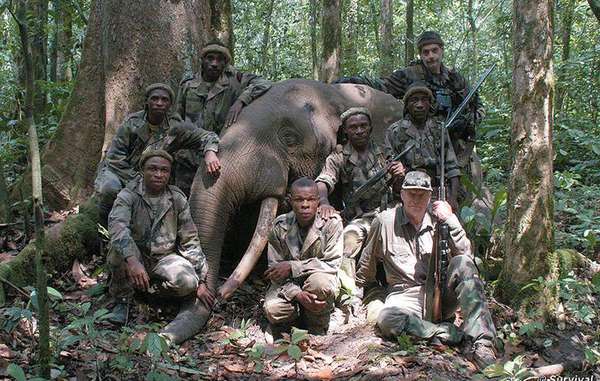
by Deep Green Resistance News Service | Nov 2, 2016 | Biodiversity & Habitat Destruction, Colonialism & Conquest
Featured image: World Wildlife Fund trustee Peter Flack with dead forest elephant. © Survival International
by Survival International
Survival International has learned that an elephant-hunting safari operation jointly owned by a French billionaire has been implicated in human rights abuses against local Baka “Pygmies” and their neighbors, including illegal evictions and torture.
The operation is based in two “protected areas” in Cameroon, leased by Benjamin de Rothschild. It offers tourists the chance to pay €55,000 to shoot a forest elephant.
Baka were evicted from their ancestral land to create the trophy hunting operation, contrary to international law. It is patrolled by soldiers, police and armed guards, and Baka have now been told they will be shot on sight if they cross it to hunt to feed their families, gather plants, or visit religious sites.
The Baka report that three of their forest camps have been burnt by wildlife guards and safari camp employees in the last year alone. Baka men hunting for food in this forest have been beaten by local police, soldiers and wildlife guards.

Benjamin de Rothschild, joint owner of a luxury elephant-hunting operation on Baka land
© JeuneAfrique
One Baka man told Survival: ”They told me to carry my father on my back. I started walking, [the guard] beat me, he beat my father. For three hours, every time I cried out they would beat me, until I fainted and fell to the ground with my father.”
Another Baka man said: “When the trophy-hunting company finds us here they burn the camps. They beat us, they search for us, they set their dogs on you, their guns on you.”
A third Baka said: “The trophy-hunting company said that if they see anyone [in the forest] bullets will fly. Now those who have family there have gone to get them out. How will we live now?”
Survival contacted Mr. de Rothschild informing him of reports of serious human rights abuses having been committed to maintain the trophy-hunting operation, but has received no reply.
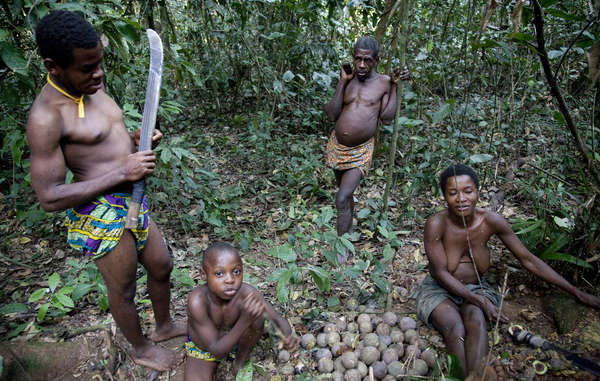
The Worldwide Fund for Nature (WWF) is very active in Cameroon, and the trophy-hunting “protected areas” form part of one of their key “conservation landscapes.” WWF has yet to comment on the allegations, or say whether it proposes to take any action.
One booking operator told Survival that: “All our luxurious fully equipped forest camps are solid construction, air conditioned with private chalets with full bathrooms and dressing parlors. Delicious multi-course cuisine is served with top shelf European wines and beverages… Our newest forest camp has a large screened in swimming pool.”
Watch: Baka plead for forest guards to leave them in peace.
© Survival International
Across the region, Baka “Pygmies” and their neighbors are being evicted from their ancestral homelands and face arrest and beatings, torture and even death while big game trophy-hunting is encouraged. WWF trustee Peter Flack has also hunted elephants in the region.
Survival’s Director Stephen Corry said: “Across Africa, rich trophy hunters are welcomed into the same areas where tribal hunters are illegally evicted from their ancestral homelands and brutalized for hunting to feed their families. This has to stop. Conservation in the Congo Basin is land theft, a continuation of colonialism. It leads to widespread and horrific human rights violations, including extrajudicial killing. Why are so few people speaking out? Survival is leading the fight against these abuses. Conservationists must respect human rights like everyone else is supposed to.”
Click here to find out more and take action.
This is not an isolated incident. Across Africa, tribal people are accused of “poaching” because they hunt to feed their families. And they face arrest and beatings, torture and death, while big game trophy hunters are encouraged. Survival International is leading the fight against these abuses.
Note: “Pygmy” is an umbrella term commonly used to refer to the hunter-gatherer peoples of the Congo Basin and elsewhere in Central Africa. The word is considered pejorative and avoided by some tribespeople, but used by others as a convenient and easily recognized way of describing themselves.
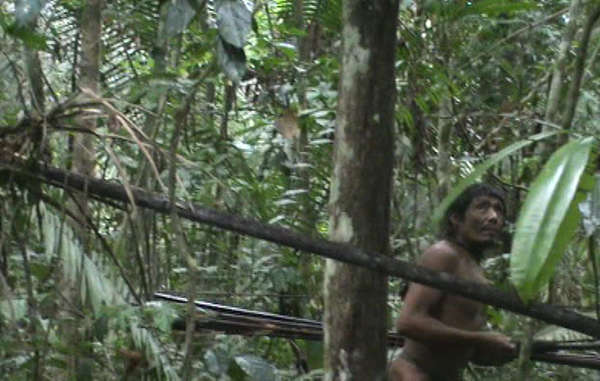
by Deep Green Resistance News Service | Oct 28, 2016 | Colonialism & Conquest
by Survival International
Waves of loggers are invading the territory of one of the most vulnerable peoples on the planet. The Indians, known as the Last of the Kawahiva, are the survivors of a larger tribe who have been killed or died of disease.
One group of loggers was recently caught by agents from FUNAI, Brazil’s Indigenous Affairs department. However, as the loggers have local political support, and FUNAI agents do not have the power to arrest suspects, the men were released. Further waves of loggers have since entered the territory.
The crisis has raised concerns among campaigners that the tribe and their rainforest home could be destroyed entirely.
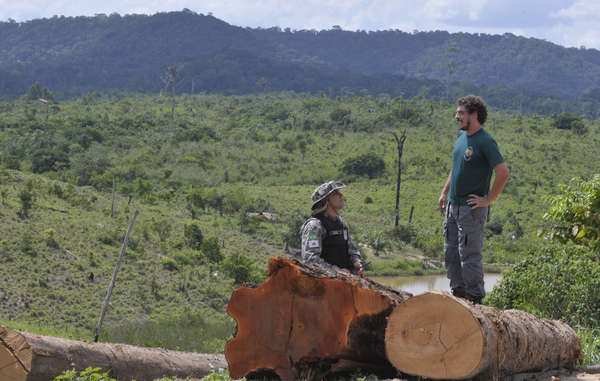
FUNAI agents work in many parts of Brazil to protect indigenous territories from loggers and other threats. © Mário Vilela/FUNAI
In April 2016, the Brazilian Minister of Justice signed a decree to create a protected indigenous territory on the tribe’s land to keep loggers and other intruders out. This was a big step forward for the Kawahiva’s lands and lives, and followed pressure from Survival’s supporters around the world. However, the decree has yet to be properly enacted and now the small team who are working to protect the land are facing severe budget cuts.
Jair Candor, an experienced FUNAI agent, said: ”The Kawahiva are trapped. If any contact happens, it will be devastating for them. The only way to ensure their survival is to map out the land and put in place a permanent land protection team. Otherwise, they will be relegated to the history books, just like so many other tribal peoples of this region.”
Oscar-winning actor Mark Rylance has narrated a film to highlight the tribe’s plight.
Survival’s Director Stephen Corry said: “Brazil committed to protecting the Kawahiva’s land in April, but with the government dragging its heels an urgent and horrific humanitarian crisis is unfolding. The Kawahiva’s land is still being invaded and their forest is still being destroyed. It’s time for Brazil to take action as it promised, before the genocide of an entire people is complete.”
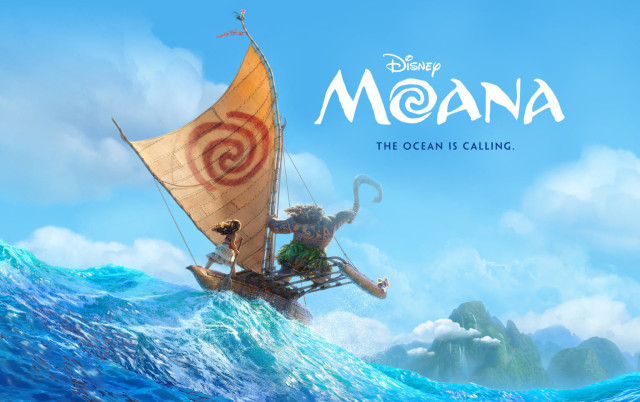
by Deep Green Resistance News Service | Oct 11, 2016 | Colonialism & Conquest
by Anne Keala Kelly
It’s a twofer.
With a Thanksgiving holiday release of “Moana,” Disney’s Polynesian cartoon extravaganza can simultaneously expand its lucrative enterprise of exploiting marginalized, indigenous peoples (Pocahontas, Lilo and Stitch, Frozen) while perpetuating American amnesia.
A note about Thanksgiving: Early feasts of giving thanks celebrated some notable atrocities committed against Native peoples, including the 1637 massacre of 700 Pequot Indians by white Christians and the 1676 butchering and beheading of Wampanoag Sachem Metacom, whose severed head was then displayed on a pike for 25 years at Plymouth. Ultimately it was President Abraham Lincoln who declared it a national holiday in 1863, less than a year after he ordered the hanging of 38 Dakota men, which remains the largest mass execution in U.S. history.
Given the pre-Halloween rollout of the Maui skin suit so that children would unwittingly promote “Moana” like human billboards, I doubt the choice of a release date was any less thought out. Some of the most experienced and powerful business minds in the world own and operate Disney — they’re not the type to leave a hundred-something million-dollar investment to chance.
Opening dates, promotion, and merchandising are carefully planned well in advance to achieve maximum financial gain. The skin suit and Thanksgiving release shouldn’t be thought of as unintended cultural faux pas — these were calculated risks. To give the benefit of the doubt to a $50-billion corporate predator waiting to vacuum up a few billion more off of our culture(s) is to agree with the offense.
Most indigenous peoples under U.S. control, certainly Hawaiians, have yet to carve out a meaningful space to represent ourselves, what we value and our reality in mass media and film largely because America’s master narrative relies on our subjugation. The truth of what matters to us undermines the colonizer’s imagineered innocence. The narrative of Hawai’i as “the Aloha State” is a perfect example — every non-Maoli living and vacationing here is able to do so because of the theft of our nationhood and the complete appropriation and subversion of our land and culture.
While there are certainly other oppressed groups, our oppressions aren’t any more equal than our successes. Hawaiian world—indigenous world is all buss up, and our narratives are convoluted. But the settler world isn’t, and neither is its story.
Our hopes, dreams and struggles are inconvenient to what Disney has chosen to produce about us. Worse yet, we’re expected to shut up and enjoy the ride everyone’s taking on our back. Yes, some of our own people, grateful for any acknowledgment, don’t recognize an insult or culture theft when they see it. Others will happily join in with the massive, commodifying monstrosity of “Moana” and buy Moana gear and computer games. (I heard that the Ala Moana Disney Store is already well-stocked.)
One Maori writer, who likes the Maui skin suit, said it’s like dressing up as Santa Claus. He’s not far off, seeing as how we’re the ones doing all the giving. He reminded me of something funny that Haunani-Kay Trask, one of our beloved sovereignty leaders, once said to me: “Yah, the haole, they stole everything we gave them.”
Being culturally poached and misrepresented isn’t flattering — it’s a threat. The historical fact is that colonization in the Pacific, and everywhere for that matter, has had catastrophic consequences for indigenous peoples in every conceivable way. And native collaboration, while highly problematic, doesn’t legitimize hijacking or pimping our knowledge, heritage and identity.
Having said that, not knowing who the members are of the Oceanic Story Trust, a group that was hand picked by Disney to shepherd the cultural content and merchandising, we can’t ask these Pacific Mouseketeers what the capital F they were thinking when they helped Disney strip mine our culture(s) for the sole purpose of making a profit.
Although bad publicity in the form of complaints that the skin suit is racist motivated Disney to take it off the shelf, they did it with a condescending, “We regret that the Maui costume has offended some,” version of an apology. I suppose that’s the best we can expect from an entity whose bottom line is protecting its investment.
But Hawaiians and other indigenous Pacific Islanders are the ones who need to think hard about what something of this magnitude will mean. Given that it’s shaping up to become this region’s cultural heist of the century (so far), we may want to try to make native sense of the intent and the processes at work here, especially us Hawaiians.
I say especially Hawaiians because so much is being done to us politically, materially, culturally and spiritually these past few years. From the mass desecration project of the Thirty Meter Telescope to the Obama administration’s determination to force feed us federal recognition against our will, ours is a never-ending struggle to simply survive in our homeland as who we are.
The cultural imperialism of Disney mirrors the military imperialism of the United States and the other industries it uses to erase our indigenous belonging: tourism and real estate. Disney’s Aulani Resort, and now its “Moana,” secures its place in the economically enforced ethnocide and culturcide that is steadily replacing us with settlers.
If the promotional trailer is anything like the film, Disney’s about to get even richer by exploiting and mocking us in deeply genealogical and spiritual ways—turning Tutu Pele into an ugly lava monster and Maui into a ridiculous, clowning sidekick. The noted psychiatrist, philosopher, revolutionary and writer Frantz Fanon was so on the mark when he said, “… Colonialism is not satisfied merely with holding a people in its grip and emptying the native’s brain of all form and content. By a kind of perverted logic, it turns to the past of the oppressed people, and distorts, disfigures and destroys it.”
Disney has reduced us and our world to a cartoon at a time when our political future is hanging in the balance, when Hawaiians absolutely need to be heard and taken seriously, not distracted by or silenced for entertainment. Disney is trying to do to our culture and identity what America is doing to our land and nationhood: we are being carved up, sold off, and drained of our mana.
Since the Maui skin suit debacle, Disney’s 21st century iteration of the white supremacist ideology that informed people like British Major General Horatio Gordon Robley, a proud collector of Maori heads, and that guy who tried to sell a Hawaiian kupuna skull on E-Bay, I’ve been thinking in metaphors. I’m looking at what’s happening right now, but looking, too, at the horizon, at what’s coming toward us, imagining what might follow, hoping that whatever it is, Hawaiians and all Pacific Islanders can face it together instead of letting it further divide us.
I have no doubt that Disney’s “Moana” will materially and psychologically aid and abet the colonial project of indigenous erasure and removal. It’s a cultural tsunami and it will impact the entire region. However, unlike natural disasters, this man-made disaster will play out over many months and years and will continue for as long as Disney can suck the marrow from our spiritual and cultural bones.
Anne Keala Kelly is the award winning filmmaker of “Noho Hewa: The Wrongful Occupation of Hawai‘i,” and a journalist whose work has appeared in The Nation and Indian Country Today, and on the Pacifica Network and Al Jazeera.
by Deep Green Resistance News Service | Sep 18, 2016 | Colonialism & Conquest
Featured image: Members of the Paraguayan Ayoreo-Totobiegosode group on the day they were contacted for the first time, in 2004. © GAT/Survival
by Survival International
The Paraguayan government has failed to act to protect a group of uncontacted tribal people, despite having been ordered to do so in February of this year.
Six months ago the Inter-American Commission on Human Rights demanded that the government stop the deforestation of the Chaco, which suffers the highest rate of deforestation in the world, and protect the vulnerable uncontacted Ayoreo Indians who live there.
However, the government has failed to stop the continuing clearance of the area’s forest, raising concerns that the uncontacted Ayoreo Indians face annihilation.
Several major ranching corporations are clearing forest to raise cattle in the Chaco, which is losing an average of 14 million trees per month. Deforestation continues and bulldozers have recently been heard on Ayoreo land.
Local organizations GAT and OPIT have been trying to persuade the government to act on the Commission’s demands but the government has so far done very little.
One Ayoreo told Survival: “We don’t want to lose our land. It’s where our fathers and grandparents lived and where our relatives live now. We want our children and grandchildren to grow up in the land of our ancestors. We are claiming this land.’’

Much of the Ayoreo Totobiegosode land is being deforested, Paraguay.
© GAT/Survival
Companies destroying the Chaco include Carlos Casado S.A. (a subsidiary of Spanish construction company Grupo San José), River Plate S.A, and Yaguarete Porá S.A, a Brazilian beef company. Yaguarete previously received Survival International’s “Greenwashing of the year” award for trying to brand an area it had heavily deforested as a “nature reserve.”
Evidence proves that tribal territories are the best barrier to deforestation and therefore the best way to protect the Chaco is to uphold the Ayoreo’s land rights. Uncontacted tribes are also the best guardians of their environment. Their knowledge is irreplaceable and has been developed over thousands of years.
In August 2016, the UN examined Paraguay’s performance on racial discrimination. Survival International submitted a report on Paraguay’s human rights violations against the Ayoreo, which was considered in the session.
Survival’s Director Stephen Corry said: “Unless Paraguay takes rapid action, the Ayoreo will become another statistic in the ongoing genocide of South America’s uncontacted peoples. The situation couldn’t be more serious: the Ayoreo face catastrophe unless their land and forest is protected from these rapacious foreign companies.”
Read more about the Ayoreo and their homeland here.

by Deep Green Resistance News Service | Sep 5, 2016 | Colonialism & Conquest
Featured Image: Police clashes. Credit: Frenadeso
By Richard Arghiris / Intercontinental Cry
Panama’s national police left approximately 20 indigenous Ngäbe protesters injured last week in what one medic described as an “absurd and irresponsible act.”
The protesters, all residents of Gualaquita, mobilized against the Barro Blanco hydro dam after the project’s owner and operator, Honduran-based Generadora del Istmo (GENISA) began flooding the Tabasará River basin with blessings from the government.
It didn’t take long for Ngäbe communities within the basin to suffer the consequences. In the community of Kiad, local road connections were washed away by the flood waters leaving entire families geographically isolated. Houses were also submerged by the rising waters, along with significant archaeological sites in the region.
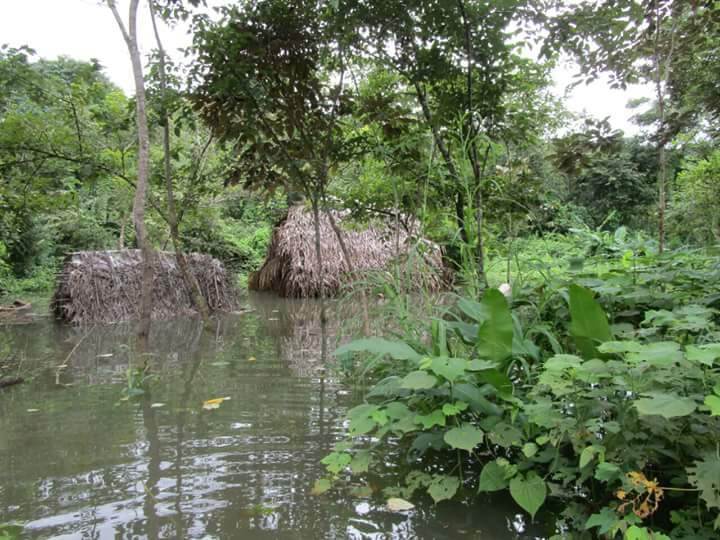
Submerged houses. Photo: Ricardo Miranda
All of the Tabasará communities affected by the flood waters were excluded from the talks that led to the agreement. They also didn’t endorse the new agreement in any way, shape, or form.
The Ngäbe community of Gualaquita is located outside of the affected area, but they too declined to endorse the agreement.
For the protesters, who are members of the Mama Tatda religion, the Tabasará River is a holy site that needs to be protected. The river is also home to ancient petroglyphs and unique Ngäbe cultural centers. To the protesters, their loss or destruction represents a violation of religious freedom.
The government wasted little time responding to the protesters.
According to a preliminary report by one of the country’s largest trade unions – the National Front for the Defense of Economic and Social Rights (Frenadeso) – around 2pm on Aug 24, 2016, some 500 police officers arrived to crush the opposition.
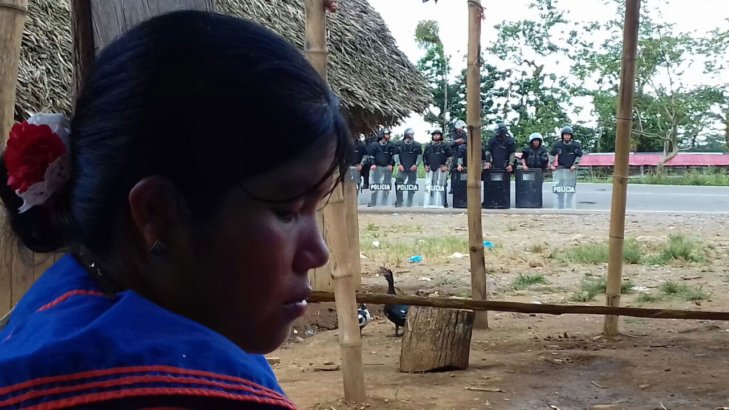
Police in Gualaquita. Credit: Frenadeso
Speaking to Frenadeso, Dr. Manuel Pardo, who attended to the injured in the aftermath of the assault, called the protesters “victims of police aggression,” stating, “There was a clear and flagrant violation of the fundamental human rights of the community of Gualaquita.”
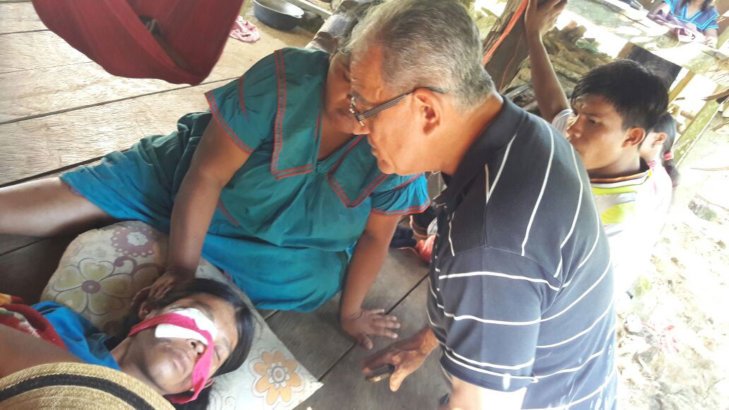
Dr. Manuel Pardo assesses the injured. Credit: Frenadeso
Osvaldo Jordan, director of the Alliance for Conservation and Development (ACD), told IC that the police didn’t just target the protesters. “[They] stormed into the whole community, detaining people who were not even in the protest… It was an outright occupation of the community, war style.”

Injuries that appear to have been inflicted by rubber bullets. Credit: Frenadeso
“The weapons that were used for the confrontation were rubber bullets, birdshot and pepper gas,” said Dr. Pardo during his visit to the community on Aug 28, 2016.
“The police entered the community and practically every house was ‘fumigated’ with pepper gas… we are still coughing and itchy… In addition to rubber bullets, birdshot and pepper gas, the attacks involved physical blows and kicking… The result was 20 people injured…”
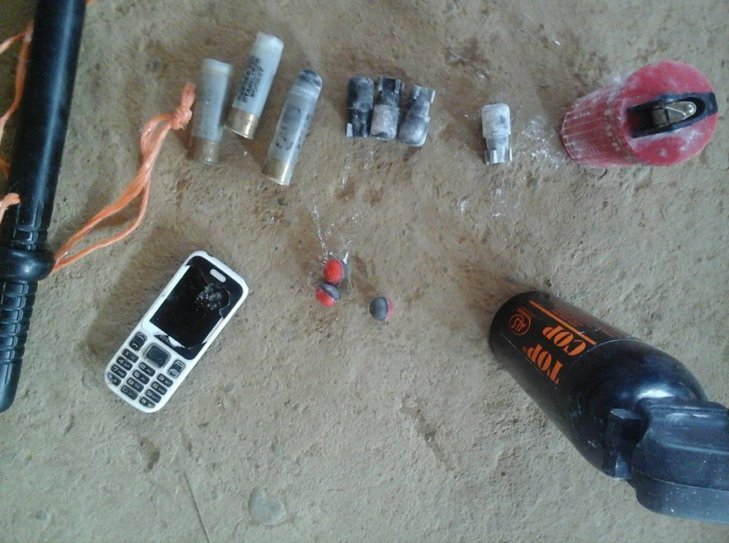
Police ammunition and equipment collected in Gualaquita. Credit: unknown
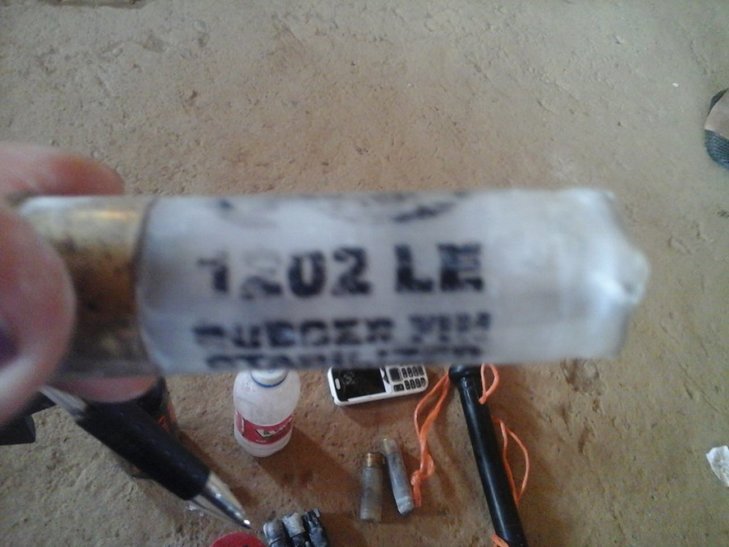
Police ammunition and equipment collected in Gualaquita. Credit: unknown
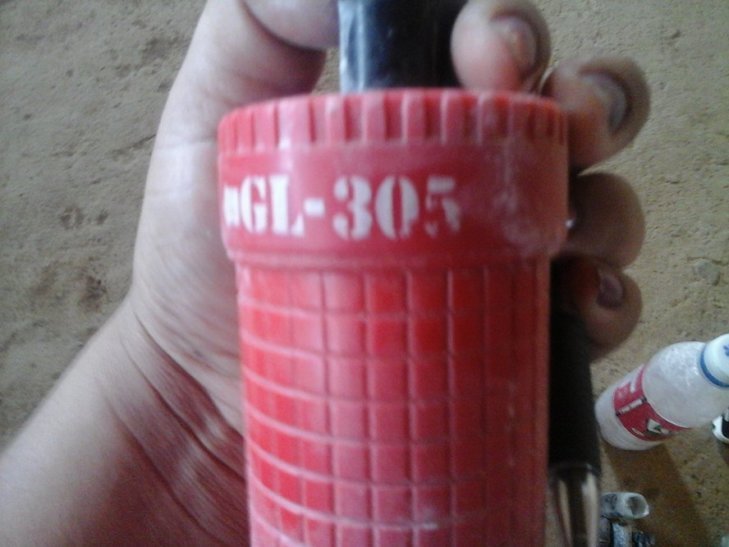
Police ammunition and equipment collected in Gualaquita. Credit: unknown
Dr. Pardo went on to explain that, three of the protesters were severely wounded during the crackdown. One person may have suffered a life-changing injury to his right eye. Another, who sustained serious head trauma, was detained by police for 48 hours before receiving medical treatment in a hospital.
Some of the injured community members reportedly refused to seek help from official institutions for fear of being arrested. Dr. Pardo described this as a “lamentable” violation of their basic human right to health care.
The Frenadeso report also alleges that the police burned a Mama Tatda flag and broke into several community stores. They apparently stole food, cell phones, chargers and hundreds of dollars in cash. They are also alleged to have threatened a storekeeper with firearms and made various death threats to different people.
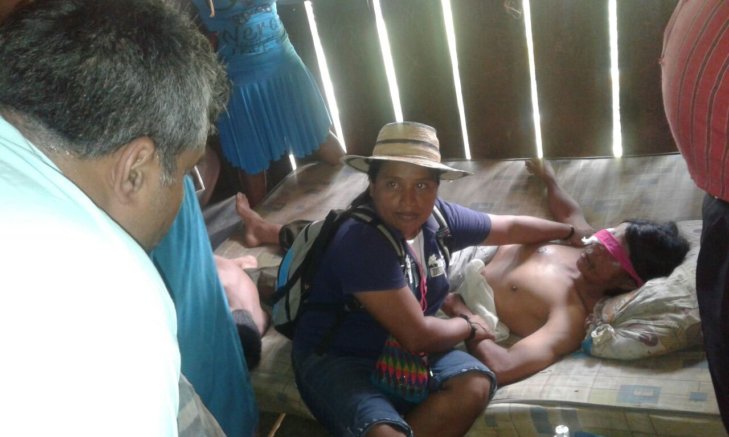
Adolfo Miranda was allegedly shot in his right eye by a rubber bullet. Credit: Frenadeso
Some of the protesters hit back at the police with rocks and slingshots. Several officers were injured and subsequently transported by plane for treatment in private hospitals.
In the aftermath of the clash, images of the injured protesters were circulated on social media, but government ministers initially denied their veracity.
“They are using old photos of other incidents,” Alexis Bethancourt, Minister of Security, told La Estrella newspaper. “This police force guarantees human rights.”
Subsequent on-the-scene reporting from national journalists such as Lissette Centen helped to confirm that the images were in fact real.
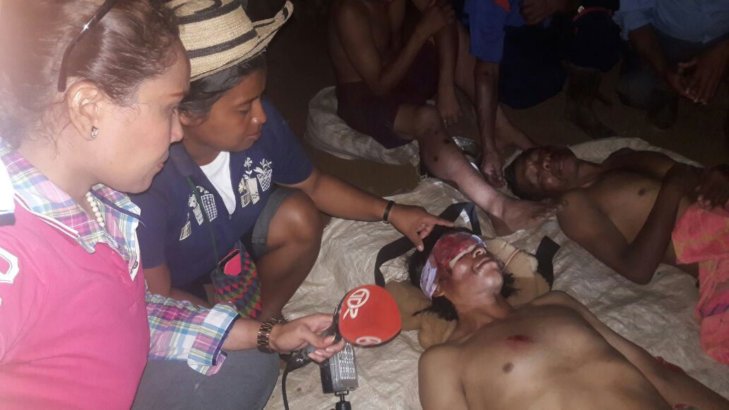
This photograph of journalist Lissette Centen at the scene verifies that the images were real. Credit: Frenadeso
According to a BARRO BLANCO. INFORME DDHH 22-6-16 (HRNP), the repression in Gualaquita is only the latest act of violence the Varela government has committed against Panama’s Indigenous Peoples.
According to eye-witness testimonies collected by the HRNP, on May 23, 2016, in an orchestrated prelude to the filling of the Barro Blanco reservoir, riot police descended on a Ngäbe protest camp, demolished a Mama Tata church and decapitated the community’s livestock. They rounded up some 30 protesters and held them for 36 hours without due process. Young children were among the detainees and one woman was apparently stripped naked in front of her family.
Despite clear threats to their safety, the Tabasará communities are determined to keep fighting Barro Blanco. Mass mobilizations are planned in different parts of the country for Monday September 5, 2016.
Meanwhile, the Ngäbe community of Kiad is at a critical juncture. According to Osvaldo Jordan, the waters of the reservoir are nearing the houses. “The main square can still be saved,” he said. The government just has to stop the flooding of Ngäbe land.
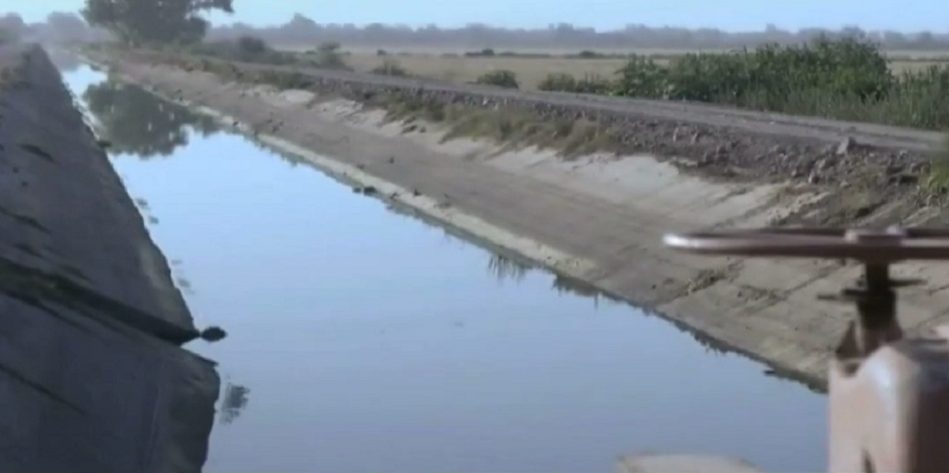
by Deep Green Resistance News Service | Aug 21, 2016 | Colonialism & Conquest
By Intercontinental Cry
In this 60-minute film, the Mexican writer, novelist and political activist Paco Taibo II travels to the territory of the Yaqui Peoples to remember the longest-running armed struggle in Mexico’s history (1867-1909); a righteous struggle that was dragged to its end, in Paco Taibo’s own words, through a malignant ten year program of “Systematic military destruction” that used “multiple mechanisms of violence, torture, mass murder [and] enslavement of a community.”
Despite the brutal hardship, the 42-year war immortalized the will of the Yaqui Nation for all days to come. Even now, more than 100 years after this forgotten history the Yaqui continue to struggle for their most basic human rights.
Today, the Yaqui may no longer carry arms, nevertheless, their struggle–like that of all Indigenous Peoples and Nations around the world–is one that can only truly end in Justice.


















